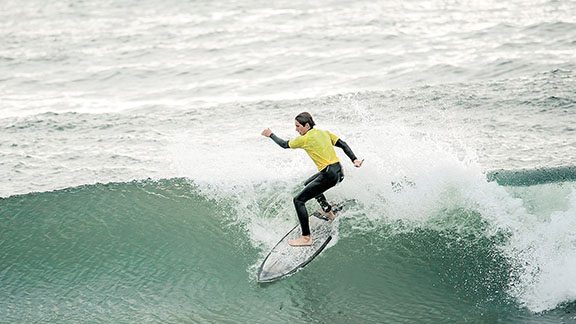
By Stephen Appezzato
Surfers and swimmers beware, entering the water at certain area beaches could pose an invisible health risk this fall as water quality monitoring lessens in the off-season.
A recent Monmouth University study found that shortly following rainfall, illness-causing enterococcus bacteria levels at beaches with stormwater discharge exceeded state health safety standards roughly half the time.
According to Jeffrey H. Weisburg, Ph.D., a specialist professor in Monmouth University’s biology department, the bacteria can lead to “respiratory infections, nausea, abdominal pain and fevers,” for swimmers. Weisburg’s research focuses on immunology and disease.
In the summer months, when many flock to New Jersey’s beaches, the state Department of Environmental Protection’s Cooperative Coastal Monitoring Program provides weekly updates on water quality, warning visitors of hazardous swimming conditions and other factors.
But from September to May, ocean pollution and water quality are not measured as often.
As surfing season picks up in the fall and spring and the water is less frequently monitored, the lack of warning systems for bacteria bloom flare-ups on beaches means “surfers could unknowingly be exposed to bacteria,” Weisburg said in a release.
“Since the restrictions on which beaches you’re allowed to surf at are lifted in the off-season, surfers should take advantage of the other beaches open to them and steer clear of outfall pipes during and after rains,” he recommended.
The research team which studied the effect of weather and ocean conditions on microbial pollution reported that these enterococcus bacteria spurts occurred within 6-24 hours of moderate rainfall.
The study was the first peer-reviewed finding which confirmed the link between illness-causing microbial pollution and rainfall. Weisburg and endowed professor of marine science Jason Adolf, Ph.D., led a team of students, collecting water samples from five Monmouth County beaches with stormwater drainage pipes.
The team tested samples for the specific bacteria while studying the relationship between precipitation, water temperature and tide stage on microbial growth.
According to the release from Monmouth University, precipitation “transports animal waste and other pollutants to beaches via stormwater discharges” and water temperature “determines how easy it is for bacteria to thrive.” The tide stage “can control whether the pollutants are diluted or concentrated.”
The study reported that recent rainfall combined with higher water temperatures “were the best predictors of high enterococcus counts.”
Enterococcus bacteria live in warm-blooded animals’ and humans’ intestinal tracts, according to the U.S. Environmental Protection Agency. The bacteria can contaminate bodies of water by runoff from fecal waste. Enterococci can lead to wound infections, urinary tract infections, intra-abdominal infections, meningitis and even infective endocarditis if it enters the bloodstream – a dangerous infection of the endocardial surfaces of the heart.
Swimmers and surfers are advised to check water quality trackers, such as the state environmental protection agency’s online reporting system, prior to entering the water. Weisburg recommended avoiding beaches with outflow pipes during and after rainfall.
According to the release, the study was published in the Environmental Monitoring and Assessment journal. “It was co-authored by Monmouth graduates Kelly Hanna and Victoria Lohnes with research contributions by Monmouth graduates Maria Riley, Skyler Post, Ariel Zavala, and Erin Conlon. Associate Professor of Geography Geoffrey Fouad made important editorial contributions to the paper. Funding for the research was provided by the Surfers Environmental Alliance, the Monmouth University School of Science and the Monmouth University Urban Coast Institute.”
Through their research, the team produced a model that can predict “the likelihood of bacteria spikes at sampling sites with accuracy,” which could be used to improve state water quality testing measures.
This article originally appeared in the August 24 – 30, 2023 print edition of The Two River Times.














